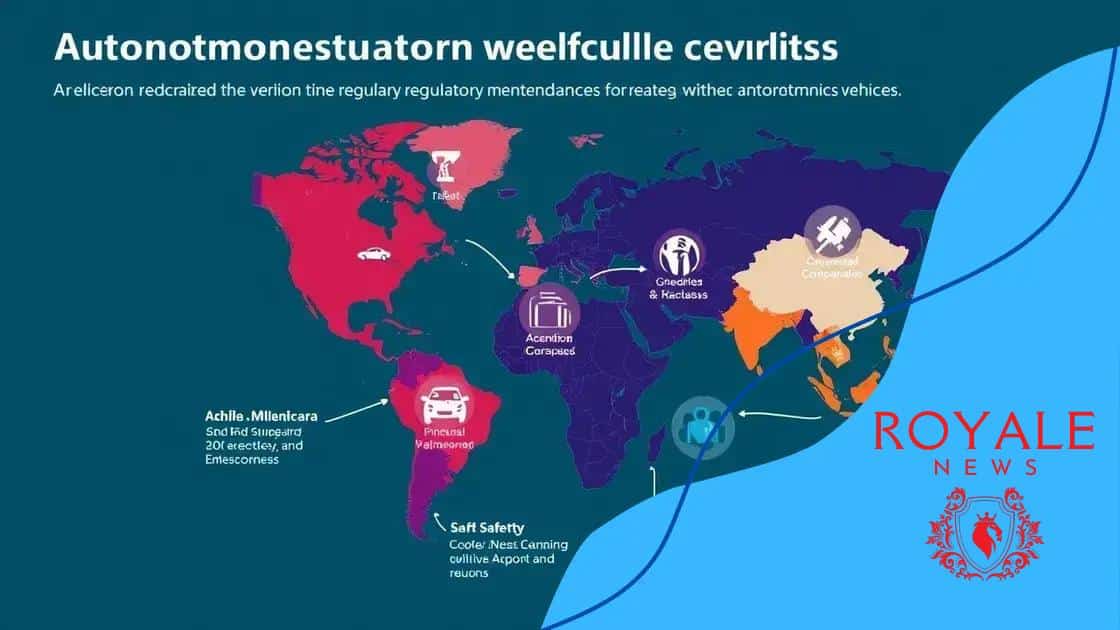Autonomous vehicle regulation updates: what you need to know

Autonomous vehicle regulation updates are crucial as they adapt to technological advancements, focusing on safety, collaboration, and sustainability to ensure effective integration into transportation systems.
Autonomous vehicle regulation updates are transforming the landscape for self-driving cars, creating a roadmap for their safe integration. You might wonder how these changes impact your daily commute and the broader transportation sector.
Current state of autonomous vehicle regulations
The current state of autonomous vehicle regulations is a critical topic as technology evolves rapidly. Governments worldwide are trying to catch up with the pace of innovation. Regulations aim to ensure safety, protect the public, and respond to the challenges of self-driving cars.
Key Challenges in Regulation
One major challenge is balancing innovation with public safety. Lawmakers face the difficult task of permitting testing while minimizing risks. They need to consider various factors, such as:
- Data privacy and security
- Liability issues in case of accidents
- Public acceptance of autonomous technology
- Infrastructure readiness to handle autonomous vehicles
As different regions implement varying regulations, companies are also adjusting their strategies. For instance, some areas have stringent rules, while others are more flexible to attract tech investments and innovation.
The Role of Testing and Data Collection
Testing is vital in shaping autonomous vehicle regulations. Companies often conduct trials to gather essential data. This data helps regulators understand vehicle performance in real-world scenarios. Furthermore, states like California and Arizona have advanced testing programs, allowing companies to demonstrate the safety and efficiency of their self-driving technology. Each test contributes valuable insights that inform future regulations.
As we look at the global landscape, it’s evident that countries like the United States, Germany, and Japan are leading the charge. These nations are pushing not only for innovation but also for comprehensive frameworks that guide the development and deployment of autonomous vehicles.
Key recent updates and their implications
Understanding the key recent updates in autonomous vehicle regulations is essential for stakeholders. With advancements in technology, regulators are continuously adapting their policies to ensure safety and efficiency. These updates play a significant role in shaping the future of transportation.
Legislative Changes
Recently, multiple regions introduced new laws aimed at autonomous vehicles. These laws encourage innovation while addressing safety concerns. For example, some states expanded testing permissions, allowing companies to operate self-driving cars without human supervision in specific zones. This change opens pathways for real-world data collection, further informing safety standards.
- Expanded testing in urban areas
- Altered liability rules for manufacturers
- Increased safety standards for software
- Incentives for companies to prioritize public safety
As regulations evolve, manufacturers must adapt quickly. Understanding these updates enables better preparedness and alignment with expectations set by lawmakers. This adaptability is crucial in a market where competition is fierce.
Impacts on Industry and Consumers
These regulatory updates significantly impact both the industry and consumers. As manufacturers adhere to new standards, they often improve their technologies. Consumers may benefit from enhanced safety features and innovations that make self-driving vehicles more reliable. However, the changes can also lead to increased costs for developers, as they invest in compliance and new technology.
Furthermore, public acceptance of autonomous vehicles hinges on their perceived safety. As laws shift, consumers become more aware of how these vehicles operate. Transparency and clarity in regulations can help alleviate fears and build trust in this emerging technology.
How different regions approach regulation

Different regions have varied approaches when it comes to regulating autonomous vehicles. Understanding these differences helps industry players navigate the complex landscape of regulations effectively. Some areas are more progressive, while others take a cautious stance.
Progressive Approaches
In places like California and Arizona, regulations are designed to foster innovation. They allow extensive testing of autonomous vehicles on public roads. These states have clear frameworks that enable companies to test without a driver present. This encourages rapid advancements in technology. In California, companies are required to submit detailed plans and safety protocols before testing.
- California offers a streamlined application process for testing.
- Arizona allows widespread use of autonomous vehicles without additional permits.
- Both states focus on data collection to improve regulations.
- Public-private partnerships enhance development and safety protocols.
These initiatives aim to create an environment where innovation thrives while maintaining safety standards.
Cautious Approaches
Contrastingly, regions like Europe and some parts of the Midwest are more cautious. Many European countries impose strict regulations and significant penalties for non-compliance, focusing on safety first. They prioritize thorough safety evaluations and impact assessments before permitting any autonomous vehicle testing on public roads. In these regions, regulations might take longer to develop but are designed for comprehensive safety. As a result, manufacturers often face significant delays in launching their technologies.
These regulatory differences show how important it is for companies to understand local laws. Consideration of the regional landscape helps businesses align their strategies with legal requirements. Ultimately, this can lead to successful integration of autonomous vehicles into transportation networks.
Challenges faced in regulating autonomous vehicles
The challenges faced in regulating autonomous vehicles are numerous and complex. As technology evolves rapidly, creating effective regulations becomes increasingly difficult. Lawmakers must navigate several hurdles to ensure safety and innovation go hand in hand.
Safety Concerns
One of the primary challenges is ensuring public safety. Regulating vehicles that operate without human input raises questions about accidents and liability. Regulators need to determine who is responsible if an autonomous vehicle is involved in a crash. This uncertainty slows the development of clear regulations.
- Establishing liability in accidents
- Ensuring robustness in self-driving software
- Defining safety standards for testing
- Managing public perception and acceptance
These issues complicate the legal landscape and hinder widespread testing.
Technological Advancements
Another challenge lies in keeping up with rapid technological advancements. Autonomous vehicle technology is continually evolving, which means that regulations can quickly become outdated. Regulators face the difficult task of updating laws to reflect new technologies without stifling innovation. Fast-paced changes can lead to gaps in the regulatory framework that leave consumers vulnerable.
Additionally, companies often develop solutions that outpace regulation. This dynamic can cause tension between regulators and tech firms, as businesses may feel limited by outdated rules while seeking to introduce new features.
The integration of data privacy regulations adds further complexity. As autonomous vehicles collect vast amounts of data, protecting user information becomes paramount. Balancing privacy with innovation creates another layer of challenge for lawmakers.
Future trends in autonomous vehicle legislation
The future trends in autonomous vehicle legislation are shaping the way we think about transportation. As technology advances, lawmakers are adapting to ensure both safety and innovation. Understanding these trends can help us anticipate how regulations will evolve.
Increased Collaboration
One trend is the increased collaboration between governments, tech companies, and research institutions. This partnership can lead to more comprehensive regulations. Collaboration allows for sharing data, insights, and developing safety standards. By working together, stakeholders can create regulations that balance innovation with public safety.
- Joint pilot programs for real-world testing
- Data sharing agreements to enhance safety
- Collaborative risk assessment frameworks
- Public forums to discuss community concerns
By fostering collaboration, regions can better prepare for the challenges posed by autonomous vehicles.
Focus on Sustainability
Another emerging trend is a growing focus on sustainability in legislation. Many lawmakers are recognizing the potential for autonomous vehicles to reduce traffic congestion and emissions. As a result, regulations may encourage the development of eco-friendly technologies. This shift aligns with global goals for reducing carbon footprints and promoting cleaner energy solutions.
Incorporating sustainability into the regulatory framework ensures that autonomous vehicles contribute positively to urban environments. Technologies that optimize fuel consumption and reduce waste will likely receive favorable treatment under future laws.
Additionally, regulations might evolve to include incentives for utilizing electric autonomous vehicles, aligning economic benefits with environmental goals.
FAQ – Frequently Asked Questions about Autonomous Vehicle Regulation
What are the main challenges in regulating autonomous vehicles?
The main challenges include ensuring public safety, determining liability in accidents, and keeping pace with rapid technological advancements.
How do different regions approach autonomous vehicle legislation?
Regions vary in their approach, with some like California promoting innovation through flexible regulations, while others focus on strict safety standards.
What trends are shaping the future of autonomous vehicle legislation?
Trends include increased collaboration between stakeholders, a focus on sustainability, and adapting regulations to support innovative technologies.
Why is collaboration important in developing regulations?
Collaboration allows for sharing data and insights, leading to more comprehensive and effective regulations that promote safety and innovation.





